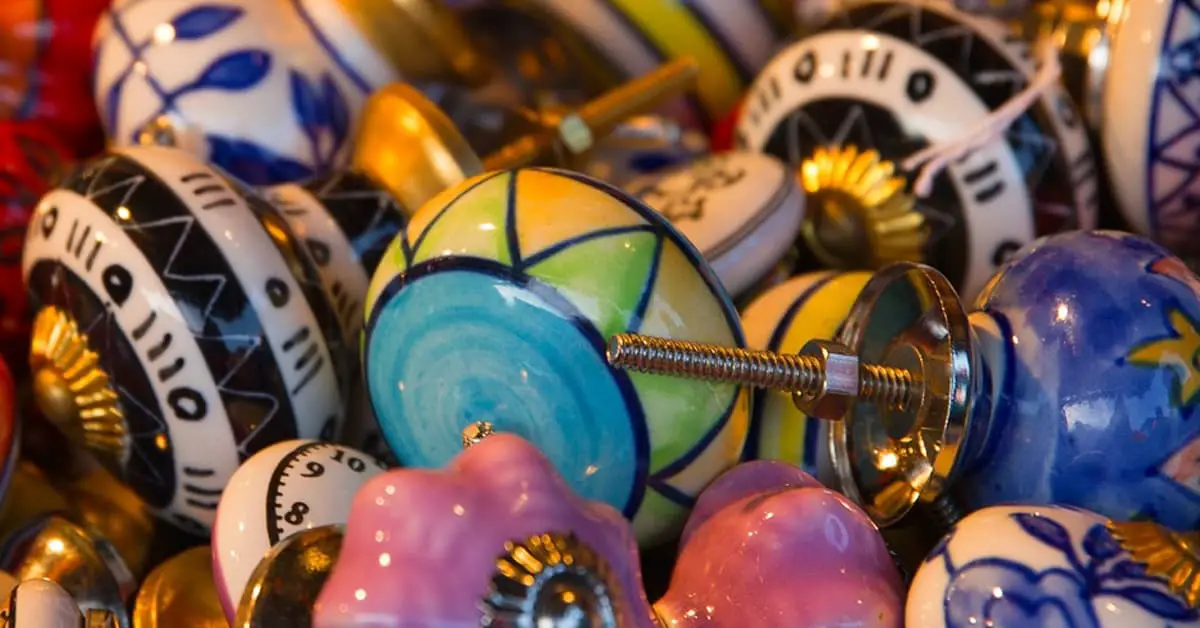It’s a common occurence to find a loose cabinet knob when you go to open a drawer. Even if you get a screwdriver and tighten it up, it will start being loose not soon after.
To keep cabinet knobs from turning, check the way the knob is secured by removing it and inspecting the threads in both the knob and the hole in the door or drawer. A little bit of glue will also help to keep the screw or bolt tight.
We’ll look at some techniques behind keeping knobs and handles straight and to stop them turning inadvertently. We’ll also look at some alternative ways using glue as well as what type of knob or handle you should use.
How Do I Make Sure Cabinet Handles Are Straight?

Measuring cabinet handles for straightness may seem easy, but the usual methods of using a rule or laser level sometimes aren’t the best.
One of the best tools for measuring if a handle is straight is called a cabinet handle mounting template. Amazon stock many varieties including the Rok Handle Drill Mounting Template which uses tabs at the edge to brace up against the edge of the cabinet door.
The various holes at standard places for knobs or handles can then be used as a guide to drill through, or you can just mark with a pencil to show where to drill later.
Remove the handle or knob from your cabinet door by unscrewing or popping it off. Find the central hole through which the handle was attached, and line it up using the Rok template. If the handle is attached at multiple points, ensure that both holes can fit into the template.
If the existing holes won’t fit into two horizontal holes on the template, it may be worth examining if one of the holes is drilled incorrectly.
The long slots on the template are perfect for handles, as long as both the holes are approximately in the same position in the slot to ensure the handle will also be lined up in the same way when attached.
There are more expensive versions of this method called cabinet jigs. The Tourace Cabinet Jig is a great example of a jig you can grab off Amazon. It comes with sliding rulers, enabling you to precisely measure out where to put the holes.
If you’re a cabinet maker or similar, a cabinet jig enables you to measure out exactly where to drill your holes and gives you more flexibility where to put them, but it doesn’t offer anywhere near the simplicity and foolproof nature of a drilling template.
How To Keep Cabinet Knobs From Turning?

The main cause of this issue is that the fastener, usually a screw, has come loose inside the cabinet knob. The fastener would usually bite into the wood or furniture material, gripping it and preventing the knob from turning.
However, over time the thread or surrounding material may shrink or expand, causing the effectiveness of the fastener to degrade, eventually leaving less material for the screw to be embedded in.
This is nothing to worry about and is very common with the wear and tear that a cabinet will go through. Humidity and temperature will also cause expansion and shrinkage.
Remove the knob and screw and inspect for what the damage is. It’s most likely the cabinet door itself, particularly if made from wood, which will have given way around the screw hole.
Check the screw holes on the cabinet handle, as these are likely to lose their threads as well. If either the screw or handle is looking unsalvageable, it’s best to try and get replacements if possible.
When replacing the fastener back in, endeavour to use washers as well. Washers should go between the bolt or screw head to give them more grip on the inside of the drawer or cabinet.
Can You Glue Cabinet Handles?

Glue is a substitute for screws and bolts for a cabinet handle but it shouldn’t be the first choice. Glue is not meant to take the type of pressure and constant strain that handles go under.
Glue is a great way to add extra strength to a drilled hole that uses a solid fastener. One great choice for making fasteners less likely to loosen over vibrations or strain is thread glue. Amazon has Loctite Threadlocker that can help really seal a fastener into a handle.
Should I Use Knobs or Pulls on Kitchen Cabinets?
In the end there are no strict rules whether to choose one or the other. There are several considerations to keep in mind when pulls will work better, but knobs also have their uses.
Pulls are bigger and generally allow your whole hand to hook in. A pull is a handle that can come in many different styles. This means it’s much better suited to heavier doors or drawers that contain a lot of heavy objects, like a pot drawer.
One other component is to recognize that knobs are very popular in older-style decors, whereas pulls and handles are a much more modern innovation.
Knobs also work well on smaller doors as they don’t take up much space. Aesthetically, it can be a better choice to have a small knob on a draw so that it doesn’t mess up the lines and spacing of the door.
Making a final decision is not easy, but a great idea is to head down to your big box hardware store. In the fittings section, they will often have samples of the knobs and handles all put on a variety of doors so that you can test them out.

